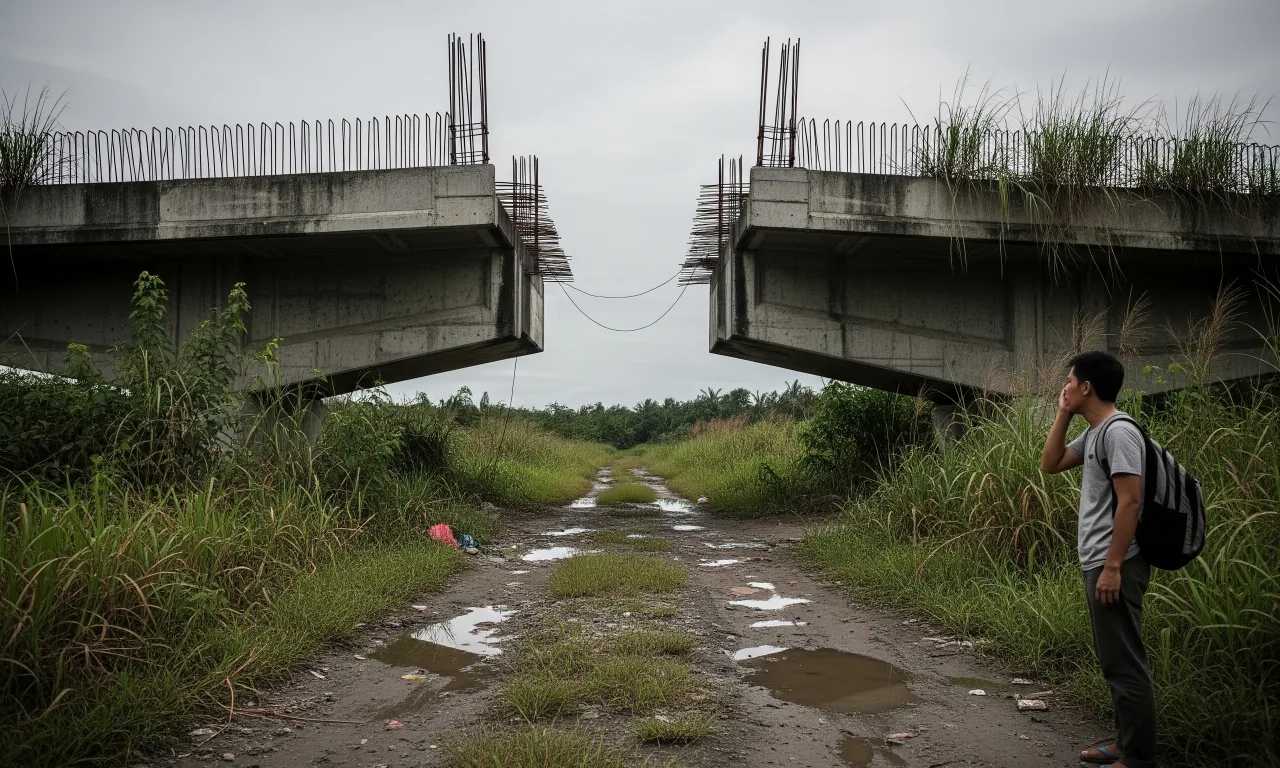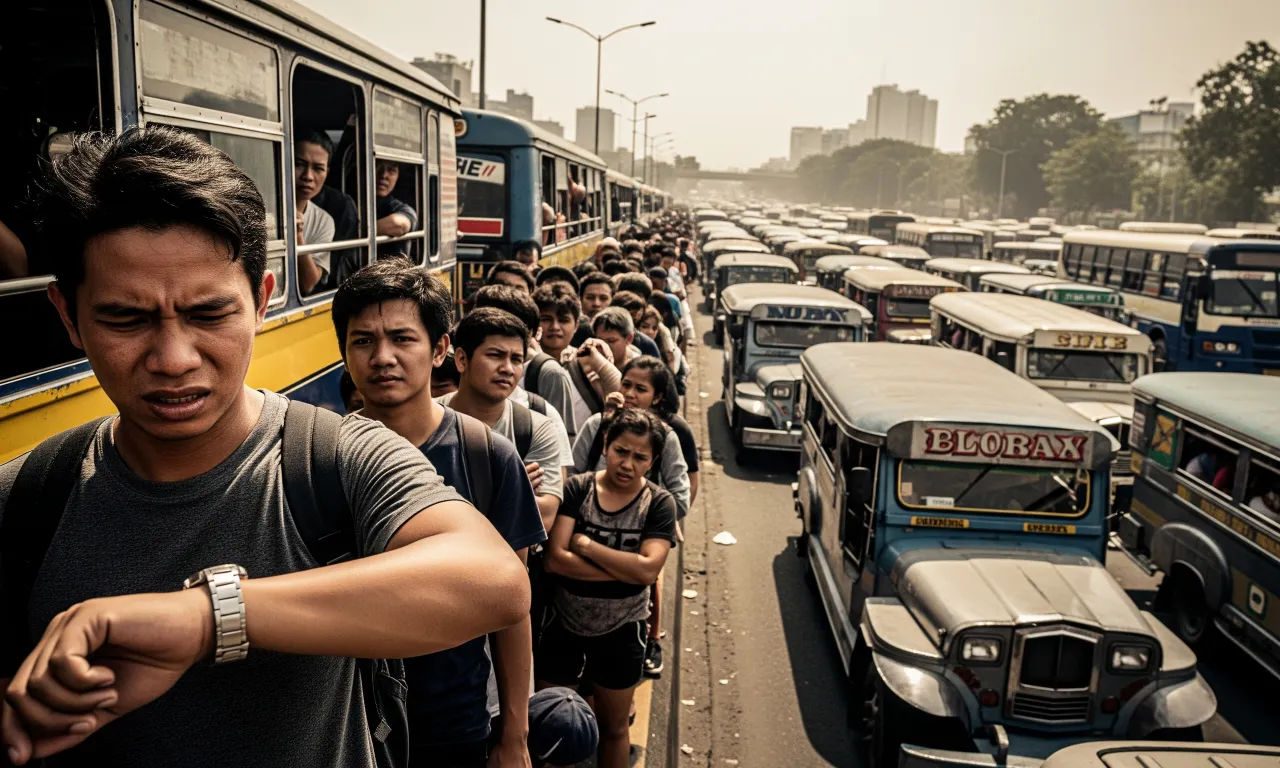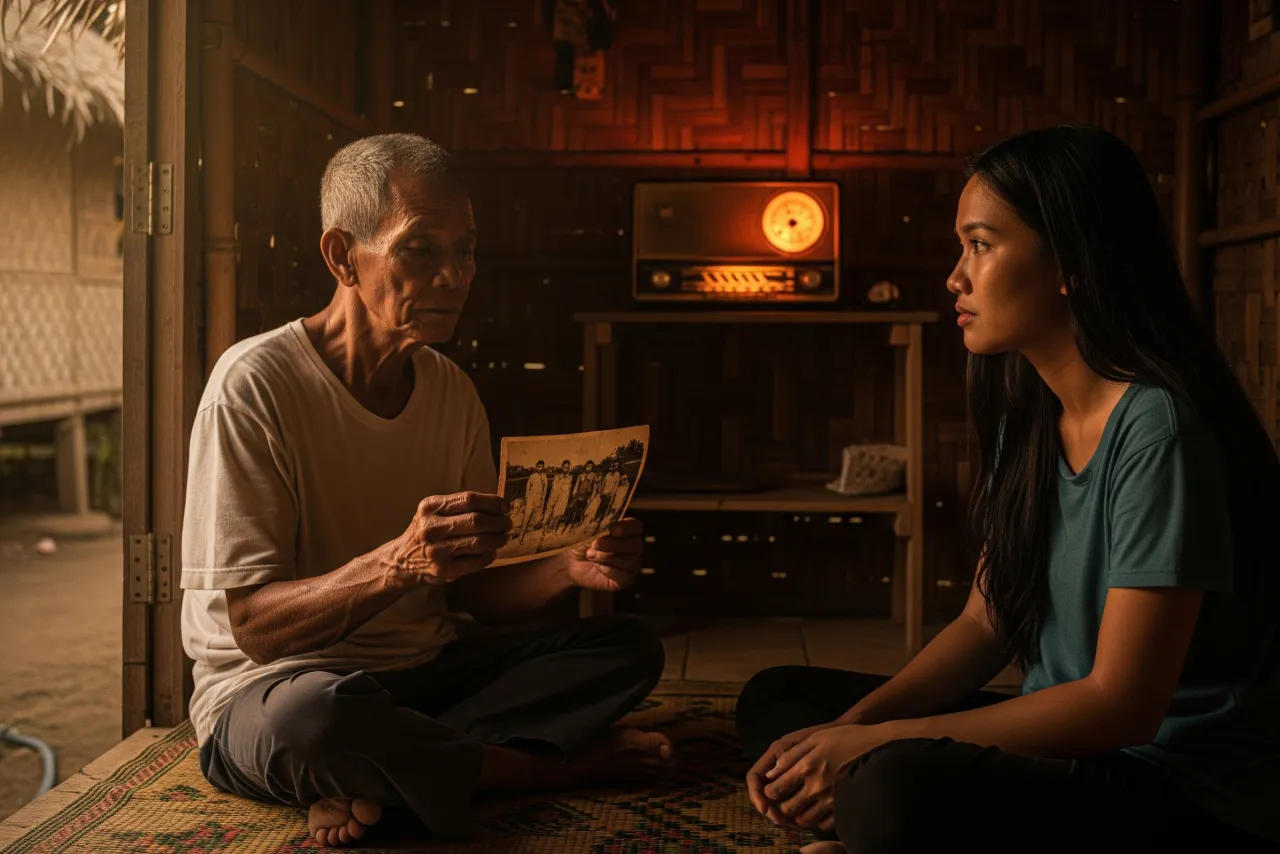💔 The Ghost of Progress: When Dreams Turn to Rust
You’ve seen it, my friend. We all have. That half-built bridge leading to nowhere. The stretch of road that suddenly turns to dirt. The public building, its skeletal frame standing stark against the sky, a silent monument to a promise unfulfilled. These aren’t just concrete and steel; they are the ghost of progress, the haunting reminders of taxpayer money seemingly poured into a bottomless pit. For civic-minded Filipinos, hardworking taxpayers, and especially socially aware millennials, these abandoned projects are a source of profound frustration, a symbol of a broken system that seems to start but never finish. We have to ask a difficult, infuriating question: Why do Public Infrastructure Projects in the Philippines Start but Never Finish?
- 💔 The Ghost of Progress: When Dreams Turn to Rust
- Blueprint for disaster: The Ideal Process vs. The Harsh Reality
- 🚧 The Seven Deadly Sins: Why Projects Get Stalled
- 💔 The Human Cost: Lives on Hold
- 🏛️ The Watchdogs: Government Oversight and Its Challenges
- 📢 The Roar of the People: Citizen Reactions and the Political Angle
- ✨ Breaking the Cycle: Solutions and Success Stories
- 🤔 FAQs about Unfinished Infrastructure
- The Final Blueprint: Demand for Transparency
This isn’t just about inconvenience. This isn’t about minor delays. This is a deep-seated, systemic problem that drains our national coffers, stifles economic growth, and, most tragically, crushes the hopes of communities yearning for development. It’s a drama that unfolds across our archipelago, from the bustling cities of Cebu to the quiet rural towns of Isabela. We are talking about billions of pesos, years of waiting, and the human cost of promises that turn to dust. This article is an investigative journey, a hard-hitting exposé that blends facts and figures with the heartbreaking realities on the ground. We will pull back the curtain on the ideal process, expose the harsh truth of its breakdown, and shed light on the pervasive issues that turn our dreams of progress into concrete nightmares.
Blueprint for disaster: The Ideal Process vs. The Harsh Reality
In a perfect world, public infrastructure projects are meticulously planned, efficiently executed, and completed on time and within budget. The blueprint is clear, designed to ensure accountability and optimal use of public funds. However, in the Philippines, the ideal often collides head-on with a harsh, frustrating reality.
📝 The Ideal Process: A Textbook Dream
The journey of a public infrastructure project, from conception to completion, is supposed to follow a rigorous, multi-stage process, designed to ensure transparency, efficiency, and public benefit. It begins with feasibility studies, where experts assess the project’s viability, economic benefits, social impact, and environmental sustainability. This crucial step determines if a project is even worth pursuing. Once deemed feasible, it moves to detailed engineering design, where plans, specifications, and cost estimates are meticulously prepared. This is where the blueprints are finalized, down to the last rebar and cubic meter of concrete.
Following the design phase, the project undergoes budget approval. This involves securing funding from the national budget (General Appropriations Act), often requiring extensive lobbying and deliberation in Congress. For larger projects, foreign loans or grants may be secured, involving complex negotiations with international lenders such as the World Bank or the Asian Development Bank, or bilateral partners like Japan. Once funding is secured, the project proceeds to bidding, where qualified contractors compete for the contract through a public and transparent process, theoretically ensuring the best value for money. The winning bidder then undertakes the construction phase, adhering to strict timelines and quality standards, with regular monitoring and inspections by government agencies. Finally, upon completion, the project is turned over to the relevant government body for operation and maintenance. This ideal timeline is a beautiful vision of efficiency and public service.
💔 The Reality Check: Where the System Breaks Down
The reality, however, is often a cruel parody of this ideal. The textbook dream quickly devolves into a bureaucratic nightmare, plagued by delays, cost overruns, and, tragically, abandonment. The very mechanisms designed to ensure efficiency—from planning to bidding—become fertile ground for complications, mismanagement, and, in some cases, outright corruption. The seamless flow of the ideal process often grinds to a halt, leaving communities in limbo and taxpayers fuming.
For instance, a project that is supposed to take two years might stretch into five, ten, or even longer. A budget initially set at ₱500 million might balloon to billions, requiring supplemental funding that further strains public resources. The meticulous plans often gather dust, while the actual construction becomes a stop-and-go affair, characterized by periods of intense activity followed by inexplicable dormancy. This breakdown is not random; it is a symptom of deep-seated issues that undermine the very foundation of public trust and efficient governance. The gap between the blueprint and the concrete reality is where the dreams of progress often turn to rust, leaving behind only the ghost of what could have been.
🚧 The Seven Deadly Sins: Why Projects Get Stalled
The reasons behind the agonizingly slow pace or outright abandonment of public infrastructure projects in the Philippines are complex and often interconnected. They form a web of bureaucratic inefficiency, political maneuvering, and, tragically, corruption. These are the “seven deadly sins” that plague our public works.
💸 Staggered Budget Releases: The Stop-and-Go Nightmare
One of the most frustrating and common causes of delay is the staggered or inconsistent release of project funds. While a project might have an approved budget, the actual money is often released in tranches, or worse, delayed due to bureaucratic bottlenecks or shifting government priorities. Imagine a contractor ready to pour concrete, but the funds for the next batch of materials haven’t arrived. This leads to work stoppages, idle equipment, and demoralized workers. “It’s like building a house but only getting paid for one wall at a time,” complained a frustrated contractor from Batangas. “How can you finish anything if the money keeps stopping?” These intermittent releases inflate costs due to remobilization fees and extended project timelines, turning a straightforward construction into a stop-and-go nightmare.
🗺️ Right-of-Way Disputes: The Landmine of Progress
Before a road can be paved or a bridge built, the government must acquire the land it will occupy. This process, known as right-of-way (ROW) acquisition, is a notorious bottleneck. Disputes often arise over land ownership, fair compensation, or the relocation of affected residents. These disputes can drag on for years, resulting in court battles and injunctions that can completely halt construction. “Our bridge project was supposed to finish last year,” shared a local official from a community in Samar. “But there’s still a family refusing to move, and the court case is taking forever. Our people are still using a makeshift bamboo bridge.” The human element, intertwined with legal complexities, renders ROW acquisition a veritable landmine for infrastructure projects, often resulting in indefinite delays.
🏗️ Contractor Bankruptcy or Incompetence: The Weak Link
Sometimes, the problem lies with the contractors themselves. A winning bidder might lack the financial capacity, technical expertise, or managerial competence to execute the project effectively. They might underbid to win the contract, only to realize they cannot complete the work profitably, leading to abandonment. Others might simply be incompetent, delivering substandard work that requires costly re-dos or failing to meet deadlines. “We had a contractor for our school building who just disappeared after a few months,” recounted a school principal in Mindoro. “The building is half-finished, and now we have to go through the whole bidding process again. Our students are still holding classes in makeshift rooms.” The failure of a single contractor can derail an entire project, wasting public funds and prolonging community suffering.
🏛️ Political Interference and Changes in Leadership: The Shifting Sands
Public infrastructure projects are inherently political. They are often used by politicians to showcase achievements, especially during election seasons. This can lead to projects being initiated hastily without proper planning, or being abandoned altogether when a new administration takes office. A new mayor, governor, or president might scrap projects initiated by their predecessors, regardless of their merit, to prioritize their own agenda or simply to deny credit to their rivals. “Every election, a new project starts, and an old one dies,” lamented a long-time resident of a city in Cebu. “It’s a cycle, pare. They want their own legacy, not the previous one’s.” This political partisanship and lack of continuity create a landscape of shifting sands, where project longevity is often determined by political cycles rather than genuine public need.
😠 Corruption and Mismanagement: The Deepest Wound
This is perhaps the most insidious and damaging cause of unfinished projects. Corruption, from padded budgets and kickbacks to ghost projects and substandard materials, siphons off public funds, leaving insufficient resources for proper execution. Mismanagement, whether due to incompetence or deliberate negligence, results in inefficient resource allocation, poor quality control, and a general lack of oversight. “The budget for our road was huge, but the asphalt is already cracking,” fumed a local community leader in Isabela. “Where did all the money go? It’s always the same story.” The Department of Public Works and Highways (DPWH) and the Commission on Audit (COA) frequently flag these issues, yet accountability remains elusive. This systemic corruption is the deepest wound, eroding public trust and ensuring that precious taxpayer money is wasted on projects that ultimately fail to benefit the people.
⛈️ Technical/Environmental Problems: The Unforeseen Challenges
Even with the best intentions, projects can face unforeseen technical or environmental challenges. Unstable soil conditions, unexpected geological formations, or severe weather events like typhoons and floods can significantly delay or even halt construction. While some of these can be mitigated with thorough feasibility studies, others are simply acts of nature that add layers of complexity and cost. “Our bridge collapsed during the last typhoon,” shared a local engineer from a coastal town in Samar. “It was built to standard, but the storm surge was just too strong. Now we have to find new funding to rebuild.” While not always due to human error, these challenges often lead to additional costs and prolonged timelines, further frustrating communities.
💰 Loan or Foreign Funding Issues: The Global Strings
For large-scale projects, foreign loans or grants are crucial. However, issues can arise if loan disbursements are delayed due to unmet conditionalities, changes in international relations, or shifts in the lending country’s priorities. The terms of these loans, as discussed in previous articles, can also be complex, and any renegotiation can lead to significant delays. “Our railway project was delayed for months because of some issues with the foreign loan agreement,” explained a government planner. “It’s not just about getting the money; it’s about managing the global strings attached.” These external factors, often beyond local control, can add another layer of unpredictability to project timelines.
💔 The Human Cost: Lives on Hold
The delays and abandonment of public infrastructure projects are not just about statistics or budget lines; they have a profound and often devastating human cost. For ordinary Filipinos, these unfinished projects represent shattered hopes, lost opportunities, and a daily struggle that could have been alleviated. It’s a silent suffering that rarely makes national headlines but is deeply felt in communities across the country.
🚌 Commuters’ Nightmare: Time, Money, and Exhaustion
For commuters, a half-finished road or a stalled bridge means longer travel times, increased transportation costs, and immense physical and mental exhaustion. Imagine a daily commute that doubles in length because a crucial bypass remains unpaved. “My travel time to work has increased by two hours because the new road is still unfinished,” lamented a call center agent from a city in Batangas. “That’s two hours I could spend with my kids or sleeping. It’s nakakapagod (tiring) and expensive.” The lost productivity, the missed family moments, and the sheer fatigue take a heavy toll on the quality of life for millions.
💸 Local Businesses Suffocating: Dreams Derailed
Local businesses often suffer immensely from stalled projects. A road closure for a perpetually delayed construction site can cut off customer access, reduce foot traffic, and ultimately lead to bankruptcy. Businesses that invested in anticipation of new infrastructure often find their dreams derailed. “Our sari-sari store was supposed to get more customers when the new bridge opened,” shared a small business owner in a rural town in Samar. “But it’s been five years, and the bridge is still half-done. Our sales are down, and we’re barely surviving.” The economic ripple effect is devastating, stifling local economies and crushing entrepreneurial spirit.
🏡 Communities in Limbo: Hopes Crushed
For communities directly affected, abandoned projects represent a betrayal of trust and a crushing of hope. A promised school building that remains a concrete shell means children continue to study in overcrowded or dilapidated classrooms. A stalled irrigation project means farmers continue to struggle with water scarcity. These delays perpetuate poverty and hinder social development, leaving communities in a perpetual state of limbo. “We were promised a new health center five years ago,” recounted a village elder from a remote community in Isabela. “Now it’s just a concrete skeleton. Our sick still have to travel far for basic medical care. It’s heartbreaking.” The human cost is immeasurable, a testament to the profound impact of government inefficiency on the lives of ordinary citizens.
🏛️ The Watchdogs: Government Oversight and Its Challenges
The Philippines has government agencies tasked with overseeing infrastructure projects and ensuring accountability. The Department of Public Works and Highways (DPWH) is the primary implementing agency, while the Commission on Audit (COA) acts as the independent watchdog. However, their roles are often fraught with challenges.
The DPWH is responsible for planning, designing, constructing, and maintaining public infrastructure. It has regional and district offices that are supposed to monitor projects on the ground. However, the sheer volume of projects, coupled with issues of technical capacity and, at times, alleged corruption within its ranks, can hamper effective oversight.
The COA, on the other hand, conducts independent audits of government spending, including infrastructure projects, to ensure that public funds are used efficiently and legally. COA reports frequently uncover irregularities, cost overruns, and instances of mismanagement or corruption in public works. However, COA’s findings often lead to recommendations rather than immediate prosecution, and the wheels of justice can turn slowly, leading to a perception of impunity. Local government units (LGUs) also play a role, particularly for locally funded projects, but their capacity and political will can vary widely. The challenge lies in translating audit findings into concrete action and holding accountable those responsible for project failures.
📢 The Roar of the People: Citizen Reactions and the Political Angle
Filipinos are not silent observers of these infrastructure failures. Their frustration often boils over, manifesting in various forms, from online outrage to direct action. These reactions, in turn, often highlight the deeply political nature of public works.
💻 The Digital Outcry: Frustration on Facebook
Social media has become a primary platform for citizens to vent their frustrations. Photos of half-finished roads, videos of dilapidated public buildings, and scathing comments about government inefficiency frequently go viral. Hashtags like #BuildBuildBuildFail or #NasaanAngProyekto (Where is the project?) trend, serving as a collective outcry. “I always post pictures of that unfinished bridge near our house,” shared a millennial from a city in Batangas on Facebook. “Maybe if enough people see it, someone in power will finally do something. It’s our money, eh!” This digital activism, while powerful in raising awareness, often struggles to translate into tangible change on the ground.
✊ Protests and Petitions: Demanding Action
Beyond online posts, frustrated citizens and affected communities sometimes resort to direct action. Local protests, petitions to government agencies, and appeals to media outlets are common ways to demand accountability and push for project completion. These actions often highlight the human cost of delays and put pressure on local and national officials.
🗓️ The Election Cycle: Projects as Political Tools
The political angle is undeniable. Infrastructure projects are often timed to coincide with election campaigns. Groundbreaking ceremonies become political rallies, and the promise of a new road or bridge is a powerful vote-getter. However, once elections are over, and particularly if there’s a change in leadership, projects initiated by previous administrations can be deprioritized, defunded, or even abandoned. “They only start projects when elections are near,” cynically remarked an elderly resident of a town in Samar. “After they win, the project just stops. It’s the same old story, pare.” This political opportunism, where public works become tools for political gain rather than genuine public service, is a major contributor to the cycle of unfinished projects.
✨ Breaking the Cycle: Solutions and Success Stories
Despite the pervasive challenges, not all public infrastructure projects are doomed to eternal delay. There are success stories, shining examples of how obstacles can be overcome with political will, effective management, and genuine commitment. These serve as beacons of hope, offering valuable lessons for the future.
🚀 Political Will and Continuity: The Key Ingredients
Projects that succeed often benefit from strong political will and continuity across administrations. When a project is genuinely prioritized and protected from political interference, it has a much higher chance of completion. The commitment of leaders to see a project through, regardless of who initiated it, is crucial. For instance, some major expressways or railway extensions have seen consistent progress because they were deemed national priorities that transcended political cycles.
🤝 Effective Project Management and Transparency
Successful projects are characterized by robust project management, strict adherence to timelines and budgets, and transparent processes. This includes thorough feasibility studies to anticipate challenges, clear contracts with penalties for delays, and rigorous monitoring and auditing throughout the construction phase. Engaging civil society organizations in monitoring can also enhance transparency. “Our local bridge project finished on time because the mayor personally oversaw it and held weekly meetings with the contractor and community leaders,” shared a resident from a city in Davao. “There was no room for palusot (excuses).”
💡 Community Engagement and Problem Solving
Engaging affected communities early in the planning process, particularly for right-of-way acquisition, can significantly reduce disputes and delays. Open communication, fair compensation, and genuine relocation assistance can turn potential roadblocks into partnerships. Creative solutions, like phased construction or alternative routes, can also help overcome technical or environmental challenges.
🤔 FAQs about Unfinished Infrastructure
Q1: Why do public infrastructure projects in the Philippines start but never finish? A: Projects often stall or are abandoned due to staggered budget releases, right-of-way disputes, contractor incompetence or bankruptcy, political interference, corruption, technical/environmental problems, and issues with foreign funding.
Q2: Does a groundbreaking ceremony mean the budget is 100% ready? A: Not necessarily. A groundbreaking ceremony often signifies the official start of a project and initial budget allocation, but subsequent budget releases can be staggered or delayed, leading to work stoppages.
Q3: Can a contractor be forced to finish a project if they abandon it? A: Legally, yes. Government contracts usually include clauses for penalties, blacklisting, and even legal action against defaulting contractors. However, the process of enforcing these can be lengthy and complex, leading to further delays.
Q4: Who is accountable for unfinished infrastructure projects? A: Accountability can lie with various entities: the implementing agency (e.g., DPWH), the contractor, local government officials, and even national politicians responsible for budget allocations or policy changes. The Commission on Audit (COA) often flags irregularities.
Q5: How do right-of-way disputes contribute to delays? A: Right-of-way disputes occur when the government needs to acquire private land for a project. Disagreements over compensation, ownership, or relocation can lead to legal battles and injunctions that halt construction for years.
Q6: What is the role of political interference in project delays? A: Political interference can lead to projects being initiated without proper planning (often for election timing), or being abandoned by new administrations to deny credit to predecessors, causing a lack of continuity.
Q7: How does corruption impact infrastructure projects? A: Corruption, through padded budgets, kickbacks, and ghost projects, diverts funds, leading to insufficient resources for proper execution, substandard materials, and ultimately, unfinished or low-quality infrastructure.
Q8: Are foreign-funded projects also prone to delays? A: Yes. While often perceived as more efficient, foreign-funded projects can still face delays due to unmet loan conditionalities, changes in international relations, or issues with loan disbursements, adding another layer of complexity.
Q9: What can citizens do to monitor public works projects? A: Citizens can monitor projects by checking DPWH websites for project status, attending local government meetings, joining civic groups that advocate for transparency, and using social media to highlight issues and demand accountability.
Q10: Are there any success stories of projects completed on time in the Philippines? A: Yes, despite the challenges, many projects are completed successfully. These often benefit from strong political will, effective project management, community engagement, and consistent funding, serving as models for future endeavors.
The Final Blueprint: Demand for Transparency
The question of Why Public Infrastructure Projects in the Philippines Start but Never Finish is a painful reflection of systemic challenges that demand urgent attention. The half-built bridges and abandoned roads are not just eyesores; they are tangible symbols of wasted resources, economic stagnation, and crushed hopes. The human cost, borne by commuters, local businesses, and entire communities, is immeasurable.
This is not a problem that a single agency or a single law can solve. It requires a fundamental shift in mindset—from political opportunism to genuine public service, from opaque processes to radical transparency. As civic-minded readers, as taxpayers, and as socially aware millennials, we have a crucial role to play. We must demand accountability from our leaders, scrutinize every project, and continuously push for reforms that ensure our hard-earned money is used wisely. We must transform our frustration into action, our complaints into collective demands for change. Only then can we truly build the Philippines we all dream of, one completed project at a time, turning the ghosts of progress into monuments of genuine development.
References
[1] Department of Public Works and Highways. (2024). Annual Infrastructure Report.
[2] Commission on Audit. (2023). Annual Audit Report on DPWH.
[3] Garcia, R. (2023). The Politics of Infrastructure: Delays and Development in the Philippines. Manila: University Press of Manila.
[4] Santos, M. (2024, October 10). “The Cost of Waiting: How Stalled Projects Affect Commuters.” The Manila Daily.
[5] Reyes, L. (2025). “Community Empowerment in Infrastructure Monitoring: A Case Study in Davao.” Journal of Philippine Development Studies, 15(1), 88-105.
[6] Villalon, A. (2020). Philippine Heritage: The Past, Present, and Future of Conservation. Manila: University of Santo Tomas Publishing House.




